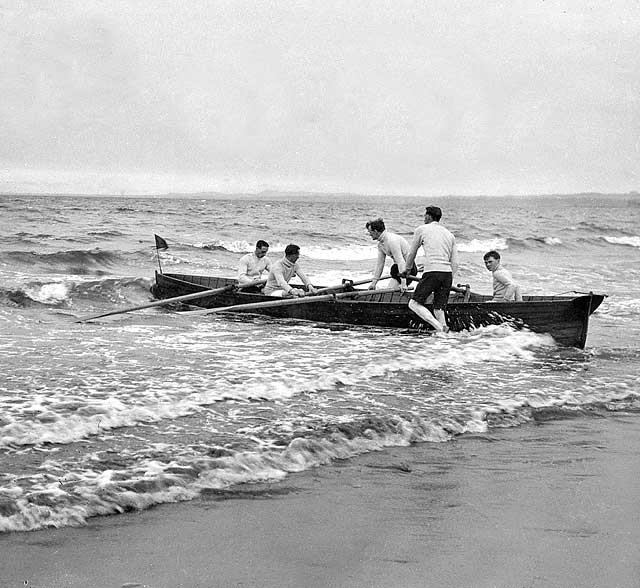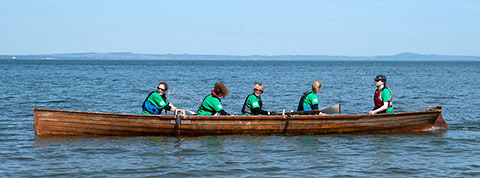|
Rowing Boat at the shore |
Answer: Portobello
See answers below for fuller details
© Reproduced with acknowledgement to John Stirling, Currie, Edinburgh: November 6, 2009 Photographer not known
|
Rowing |
|
Old Photo Thank you to John Stirling for allowing me to reproduce this photo. The photo is taken from a collection of lantern slides that John rescued from being destroyed in 1974. The photographer is not known. Some of the other slides from this series are known to have been taken between about 1910 and 1920. |
|
Who? When? Where? What is this group of rowers, and where are they? They appear to be arriving at or leaving the shore, possibly somewhere on the Firth of Forth, near Edinburgh. |
|
Answers? If you know the answer to either of the questions above, please email me. Thank you. Peter Stubbs: December 1, 2009 |
|
Answer 1. David King Trinity, Edinburgh |
|
Thank you to John Hadden who for replying: |
|
Portobello? "Could this have been taken on Portobello beach? My thoughts are that it could well be members of Portobello Rowing Club, which had a large wooden clubhouse / boat store on the Promenade, at the foot of Melville Street (now Bellfield Street) ***. My late father was a member, not at the period you suggest but in the late 1930s. The coastline in the background looks to me like East Lothian, long before Cockenzie Power Station was there as a landmark. I'll be interested to see any other contributions - I'm not certain I have got the name of the club exactly right. There are flats on the site now, built a few years ago." *** Update: David King subsequently wrote. "Archie Foley was right in 'Answer 2' below. The clubhouse was at the foot of Pitt Street (now Pittville Street), not Melville Street". |
|
David King, Trinity, Edinburgh: December 2, 2009 |
|
Answer 2. Archie Foley Joppa, Edinburgh |
|
Thank you to Archie Foley, author of books on Portobello, for sending me the following reply. Archie sent me this reply before I updated the web site to include David King's reply above. |
|
Archie wrote: Portobello? "If that is land that I can make out vaguely in the background, then the photograph might be Portobello, with the bay sweeping round to East Lothian. Portobello had two sea rowing clubs from late 19th century to mid-20th century: - Portobello Amateur Rowing Club and - The Eastern Amateur Rowing Club. Both had club houses in the same wooden building on the corner of Pittville Street and Promenade." |
|
Two More Rowing Photos Thank you to Archie Foley for sending me me two photos of rowing at Portobello. I hope to be able to add these to the EdinPhoto web site, but first I'll have to seek permission to reproduce them on the site. These photos show: a) a view of several rowing boats that look similar to the one in the photo at the top of this page. The photo was take from a few hundred yards out in the Firth of Forth, looking back towards the outer end of Portobello Pier and the buildings on Portobello Promenade. This photo was taken at a Portobello Regatta. It has been used to create a postcard. Here is a copy of the postcard. It was written on July 23, 1903. b) a view of a single boat, similar to the one in the photo at the top of this page. No land is visible in the background of this photo; it may have been taken looking out to sea. This photo is of a crew from The Eastern Amateur Rowing Club competing at Portobello in 1955. Here is a copy of the photo. |
|
Archie added: Portobello Regattas "Regattas were very popular attracting crews not only from around Scotland but also the north of England. These open- water boats, known as Jolly Boats, I'm told, seemed to have kept their distinctive design over a long period of time." |
|
Archie Foley, Joppa, Edinburgh: December 3, 2009 |
|
Answer 3. George Neilson Edinburgh |
|
Thank you to George Neilson who replied with further details. George wrote |
|
Regatta "The Photo is of a Portobello Class Jollyboat leaving Portobello Beach about Pitt(ville) Street area during a regatta. They are leaving the beach as the rudder is attached. Coming ashore, the boats beached stern-first, the cox having first removed and taken onboard the rudder to save damage on contact with the beach. The crew could maintain more control this way with the boat facing into the seas. The bow flag indicates competing in a regatta. It shows by colour the course 'Inshore', 'Middle', 'Offshore'. The start was from the clubhouse/baths area. The course went to individual buoys off Joppa then turned and back to finish, a distance of approx one mile." |
|
Jollyboats "There were three classes of Jollyboats used in Scotland. - The 'Portobello Class' was clinker-built and of heavy design with a keel approx 2" deep to withstand the sometimes rougher weather conditions at Portobello. - The 'Second Class' Jollyboats were carvel-built with a keel approx 1" deep and of light construction. They were used at South Queensferry and on the Clyde. - 'First Class' Jollyboats were carvel built and without keel. They were used on the upper reaches of the Clyde (Glasgow Green) and the lower Clyde." |
|
Championships Annual Scottish Championships were held at Portobello in three grades: - 'Maiden' (never having won a race) - 'Junior' (one win this season) - 'Senior' (having won more than one regatta). Crews came from all over Scotland to compete at Portobello in the 1920s to 1960s: - Montrose - Ferryden - Dundee Corinthian - Newport - Aberdour - South Queensferry - Stirling - Loch Lomond - Clyde - Dumbarton - Clydesdale - Newark - Murrayshore - Daveyshore - Greenock (Royal West of Scotland) - Berwick on Tweed (from England)." |
|
Portobello Boats "Crews from: - Portobello Amateur Rowing Club (PARC) and - Eastern Amateur Rowing Club (EARC) competed in the regattas. The boat in the photograph is probably from PARC. PARC named their boats after local areas: - 'Brunstane' - 'Lismore' - 'Abercorn' - etc EARC used a water theme: - 'Mermaid' - 'Sylph' - 'Nymph - 'Naiad'." |
|
Portobello Boats "The PARC and EARC clubhouses were separate, but they shared the same corner plot Pitt Street and the Promenade as the Marine Café, owned by the Fusco family who provided one of the trophies (Junior Championship) for the annual competitions. Through lack of interest, the clubhouses and Café were demolished and were replaced with flats" |
|
George Neilson, Edinburgh: November 11, 2010 |
|
Answer 4. George Neilson Edinburgh |
|
Thank you to George Neilson who replied with further details about the 1955 rowing photo provided by Archie Foley in his 'Answer 2' above. George wrote: |
|
Eastern Amateur Rowing Club Winning Crew - 1955 "The winning Eastern Crew in this 1955 photo was: - Jim Anderson (stroke) - George Peat (3) - Douglas McLennan (2) - Tom Forsyth (bow). I cannot remember the cox's name." George Neilson, Edinburgh: November 11, 2010 |
|
Answer 5. Max Blinkhorn Portobello, Edinburgh |
|
Thank you to Max Blinkhorn, Portobello, Edinburgh who saw the photo at the top of this page and sent the message and photo below. |
|
Max wrote: Jolly Boats "In case you don't know (I didn't know!) the boat in the photo at the top of this page is called a jolly boat. These craft were very lightly-built. They were designed for fast rowing by the like of the guys in this photo. They are very wobbly things - not for the uninitiated. The design descended, we are told, from the boats that used to take crews ashore from sailing ships. We were told that there was one of these boats at Broughty Ferry Boat Club. We rescued it and brought it to Portobello. The photo of it below was taken off the beach at Portobello in 2011." © Reproduced with acknowledgement to Max Blinkhorn, Portobello, Edinburgh Max Blinkhorn, Portobello, Edinburgh: 4 April + 12 May 2013 |




